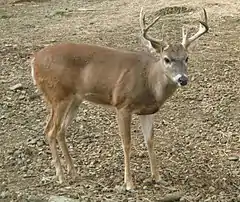| Odocoileini | |||||
| Pocock, 1923[1] | |||||
 Przedstawiciel plemienia – samiec mulaka białoogonowego (Odocoileus virginianus) | |||||
| Systematyka | |||||
| Domena | |||||
|---|---|---|---|---|---|
| Królestwo | |||||
| Typ | |||||
| Podtyp | |||||
| Gromada | |||||
| Podgromada | |||||
| Infragromada | |||||
| Rząd | |||||
| Podrząd | |||||
| Infrarząd | |||||
| Rodzina | |||||
| Podrodzina | |||||
| Rodzaj |
Odocoileini | ||||
| Typ nomenklatoryczny | |||||
|
Odocoileus Rafinesque, 1832 | |||||
| |||||
| Rodzaje | |||||
| |||||
Odocoileini – plemię ssaków z podrodziny saren (Capreolinae) w obrębie rodziny jeleniowatych (Cervidae).
Zasięg występowania
Plemię obejmuje gatunki występujące w Eurazji i Ameryce[12].
Systematyka
Podział systematyczny
Do plemienia należą następujące występujące współcześnie rodzaje[13][12][14]:
- Rangifer C.H. Smith, 1827 – renifer – jedynym przedstawicielem jest Rangifer tarandus (Linnaeus, 1758) – renifer tundrowy
- Pudu J.E. Gray, 1852 – pudu
- Ozotoceros Ameghino, 1891 – sarniak – jedynym przedstawicielem jest Ozotoceros bezoarticus (Linnaeus, 1758) – sarniak pampasowy
- Blastocerus J.A. Wagner, 1844 – jeleniak – jedynym żyjącym współcześnie przedstawicielem jest Blastocerus dichotomus (Illiger, 1815) – jeleniak bagienny
- Hippocamelus Leuckart, 1816 – huemal
- Bisbalus Sandoval, Jędrzejewski, Molinari, Vozdova, Cernohorska, Kubickova, Bernegossi, Caparroz & Duarte, 2024 – jedynym przedstawicielem jest Bisbalus citus (Osgood, 1912)
- Passalites Gloger, 1841 – jedynym przedstawicielem jest Passalites nemorivagus (F. Cuvier, 1817) – mazama amazońska
- Subulo C.H. Smith, 1827 – jedynym przedstawicielem jest Subulo gouazoupira (G. Fischer, 1814) – mazama szara
- Mazama Rafinesque, 1817 – mazama
- Odocoileus Rafinesque, 1832 – mulak
Opisano również kilka rodzajów wymarłych:
- Agalmaceros Hoffstetter, 1952[15] – jedynym przedstawicielem był Agalmaceros blicki (Frick, 1937)
- Antifer Ameghino, 1889[16]
- Charitoceros Hoffstetter, 1963[17] – jedynym przedstawicielem był Charitoceros tarijensis (Hoffstetter, 1952)
- Epieuryceros Ameghino, 1889[18] – jedynym przedstawicielem był Epieuryceros truncus Ameghino, 1889
- Morenelaphus Carette, 1922[19]
- Navahoceros Kurtén, 1975[20] – jedynym przedstawicielem był Navahoceros fricki (Schultz & Howard, 1935)
- Paraceros Ameghino, 1889[21] – jedynym przedstawicielem był Paraceros fragilis (Ameghino, 1888)
Uwagi
- ↑ Typ nomenklatoryczny: Rangifer C.H. Smith, 1827.
- ↑ Typ nomenklatoryczny: Elaphalces Brookes, 1828 (= Odocoileus Rafinesque, 1832).
- ↑ Typ nomenklatoryczny: Mazama C.H. Smith, 1827.
- ↑ Typ nomenklatoryczny: Subulus Brookes, 1828 (= Odocoileus Rafinesque, 1832).
- ↑ Pisownia oryginalna; takson zdefiniowany jako podrodzina w obrębie Bovidae.
- ↑ Typ nomenklatoryczny: Pudu J.E. Gray, 1852.
- ↑ Typ nomenklatoryczny: Blastocerus Wagner, 1844.
Przypisy
- 1 2 3 4 R.I. Pocock. On the External Characters of Elaphurus, Hydropotes, Pudu, and other Cervidae. „Proceedings of the Zoological Society of London”. 1923 (1), s. 206, 1923. (ang.).
- ↑ Brookes 1828 ↓, s. 61.
- 1 2 3 Brookes 1828 ↓, s. 62.
- ↑ J.E. Gray: Catalogue of the specimens of Mammalia in the collection of the British Museum. Cz. 3. London: The Trustees, 1852, s. 188. (ang.).
- ↑ J.E. Gray: Catalogue of ruminant Mammalia (Pecora, Linnæus) in the British Museum. London: British Museum, 1872, s. 66. (ang.).
- ↑ L. Kraglievich. Contribución al conocimento de los ciervos fósiles del Uruguay. „Anales del Museo de Historia Natural de Montevideo”. 3 (2), s. 426, 1932. (hiszp.).
- ↑ Simpson 1945 ↓, s. 154.
- ↑ Simpson 1945 ↓, s. 155.
- ↑ P. Hershkovitz. Neotropical deer (Cervidae). Part I. Pudus, genus Pudu Gray. „Fieldiana Zoology”. New series. 11, s. 8, 1982. (ang.).
- ↑ Heckeberg i in. 2016 ↓, s. 16.
- ↑ Heckeberg i in. 2016 ↓, s. 17.
- 1 2 C.J. Burgin, D.E. Wilson, R.A. Mittermeier, A.B. Rylands, T.E. Lacher & W. Sechrest: Illustrated Checklist of the Mammals of the World. Cz. 2: Eulipotyphla to Carnivora. Barcelona: Lynx Edicions, 2020, s. 316–320. ISBN 978-84-16728-35-0. (ang.).
- ↑ N. Upham, C. Burgin, J. Widness, M. Becker, C. Parker, S. Liphardt, I. Rochon & D. Huckaby: Treeview of Mammalian Taxonomy Hierarchy. [w:] ASM Mammal Diversity Database (Version 1.12) [on-line]. American Society of Mammalogists. [dostęp 2024-01-08]. (ang.).
- ↑ Nazwy zwyczajowe za: W. Cichocki, A. Ważna, J. Cichocki, E. Rajska-Jurgiel, A. Jasiński & W. Bogdanowicz: Polskie nazewnictwo ssaków świata. Warszawa: Muzeum i Instytut Zoologii PAN, 2015, s. 171–174. ISBN 978-83-88147-15-9. (pol. • ang.).
- ↑ R.J. Hoffstetter. Les mammifères pléistocènes de la république de l’Équateur. „Mémoires de la Société Géologique de France”. 66, s. 361, 1952. (fr.).
- ↑ Ameghino 1889 ↓, s. 610.
- ↑ R.J. Hoffstetter. La faune pléistocène de Tarija (Bolivie). Note préliminaire. „Bulletin du Muséum national d’histoire naturelle”. 2e série. 35 (2), s. 201, 1963. (fr.).
- ↑ Ameghino 1889 ↓, s. 613.
- ↑ E. Carette. Cérvidos actuales y fósiles de Sudamérica. Revisión de las formas extinguida pampeanas. „Revista del Museo de la Plata”. 26, s. 461, 1922. (hiszp.).
- ↑ B. Kurtén. A new Pleistocene genus of American mountain deer. „Journal of Mammalogy”. 56 (2), s. 507, 1975. DOI: 10.2307/1379377. (ang.).
- ↑ Ameghino 1889 ↓, s. 605.
Bibliografia
- J. Brookes: A catalogue of the Anatomical and Zoological Museum of Joshua Brookes. Cz. 16. London: Richard Taylor, 1828, s. 1–123. (ang.).
- F. Ameghino. Contribución al conocimiento de los mamiferos fósiles de la República Argentina. „Acta de la Academia Nacional de Ciencias Exactas”. 6, s. 1–1027, 1889. (hiszp.).
- G.G. Simpson. The principles of classification and a classification of mammals. „Bulletin of the American Museum of Natural History”. 85, s. 1–350, 1945. (ang.).
- N.S. Heckeberg, D. Erpenbeck, G. Wörheide & G.E. Rössner. Systematic relationships of five newly sequenced cervid species. „PeerJ”. 4, s. e2307, 2016. DOI: 10.7717/peerj.2307. (ang.).
This article is issued from Wikipedia. The text is licensed under Creative Commons - Attribution - Sharealike. Additional terms may apply for the media files.